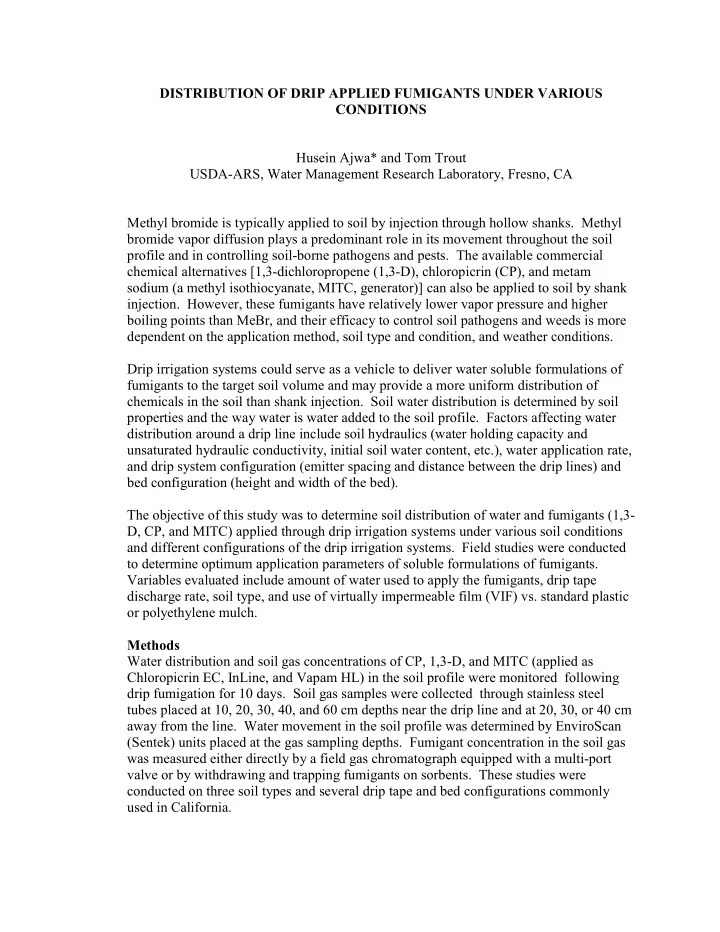

DISTRIBUTION OF DRIP APPLIED FUMIGANTS UNDER VARIOUS CONDITIONS Husein Ajwa* and Tom Trout USDA-ARS, Water Management Research Laboratory, Fresno, CA Methyl bromide is typically applied to soil by injection through hollow shanks. Methyl bromide vapor diffusion plays a predominant role in its movement throughout the soil profile and in controlling soil-borne pathogens and pests. The available commercial chemical alternatives [1,3-dichloropropene (1,3-D), chloropicrin (CP), and metam sodium (a methyl isothiocyanate, MITC, generator)] can also be applied to soil by shank injection. However, these fumigants have relatively lower vapor pressure and higher boiling points than MeBr, and their efficacy to control soil pathogens and weeds is more dependent on the application method, soil type and condition, and weather conditions. Drip irrigation systems could serve as a vehicle to deliver water soluble formulations of fumigants to the target soil volume and may provide a more uniform distribution of chemicals in the soil than shank injection. Soil water distribution is determined by soil properties and the way water is water added to the soil profile. Factors affecting water distribution around a drip line include soil hydraulics (water holding capacity and unsaturated hydraulic conductivity, initial soil water content, etc.), water application rate, and drip system configuration (emitter spacing and distance between the drip lines) and bed configuration (height and width of the bed). The objective of this study was to determine soil distribution of water and fumigants (1,3- D, CP, and MITC) applied through drip irrigation systems under various soil conditions and different configurations of the drip irrigation systems. Field studies were conducted to determine optimum application parameters of soluble formulations of fumigants. Variables evaluated include amount of water used to apply the fumigants, drip tape discharge rate, soil type, and use of virtually impermeable film (VIF) vs. standard plastic or polyethylene mulch. Methods Water distribution and soil gas concentrations of CP, 1,3-D, and MITC (applied as Chloropicrin EC, InLine, and Vapam HL) in the soil profile were monitored following drip fumigation for 10 days. Soil gas samples were collected through stainless steel tubes placed at 10, 20, 30, 40, and 60 cm depths near the drip line and at 20, 30, or 40 cm away from the line. Water movement in the soil profile was determined by EnviroScan (Sentek) units placed at the gas sampling depths. Fumigant concentration in the soil gas was measured either directly by a field gas chromatograph equipped with a multi-port valve or by withdrawing and trapping fumigants on sorbents. These studies were conducted on three soil types and several drip tape and bed configurations commonly used in California.
Results The concentrations of 1,3-D (from InLine) in the soil gas were greatest after 24 to 36 hrs following application. The concentration in the soil gas of any of the fumigants studied was below the detection level after 14 days following application. Figure 1 shows an example of monitored 1,3-D concentrations after drip fumigation with one rate of InLine (393 L ha -1 ) applied in three amounts of irrigation water to strawberry beds (76 cm wide) through two drip tapes. The concentration of 1,3-D in the irrigation water was 1060, 640, and 450 mg L -1 when applied in 26, 43, and 61 mm, respectively. Results for the Watsonville soil (a sandy loam soil) indicated that a minimum of 40 mm of water is needed to deliver sufficient fumigant horizontally 30 cm (i.e., to the edge of strawberry beds) using two drip tapes (each located 12 cm from the bed center). In general, higher amount of irrigation water resulted in greater fumigant concentration in the gas phase across the soil profile. With any amount of water used, fumigant concentrations were very small in the soil gas at depths below 60 cm. Figure 2 shows an example of 1,3-D concentrations after drip fumigation with InLine applied under a VIF and standard polyethylene mulch at 236 L ha -1 in 43 mm water. Greater concentrations of 1,3-D in the soil profile and a more uniform distribution across the bed were found under VIF than standard film. These results indicate that reduced rates of fumigants are possible if VIF is used in drip fumigation. This research will continue to optimize application techniques of fumigants through various configurations of drip irrigation systems for different soil types and climatic conditions.
Center Edge Center Edge Center Edge 43 m m w ater 26 m m w ater 61 m m w ater 10 1500 0 0 1250 0 0 3 0 2500 1000 5 2 2000 20 2000 0 5 7 1500 1500 Depth (cm ) 30 0 500 0 0 1 1000 40 250 500 50 500 60 µ g L-1 air) in the gaseous phase of Fig. 1. 1,3-dichloropropene (1,3-D) concentration ( µ µ µ W atsonville soil 24 hrs after drip application of InLine at 393 L ha-1 (58% 1,3-D) Center Edge Center Edge Virtually imperm eable film Standard PE film 10 1400 800 700 1200 600 20 500 Depth (cm ) 0 0 4 0 0 1 0 30 0 0 3 800 40 2 0 0 600 0 0 50 4 100 200 60 µ g L -1 air) Fig. 2. 1,3-dichloropropene (1,3-D) concentration ( µ µ µ in the gaseous phase of W atsonville soil 24 hrs after drip application of InLine at 236 L ha -1 (58% 1,3-D)
Recommend
More recommend